Joint Design of a Simultaneous Reflection and Transmission RIS in Mode-Switching Mode to Assist NOMA Systems
Abstract
1. Introduction
2. System Model and Problem Formulation
2.1. System Mode
2.2. Problem Formulation
3. Channel Feature Extraction and Clustering of Users and STAR-RIS Elements
3.1. Channel Feature Extraction Using UMAP
3.2. User Clustering
3.3. STAR-RIS Element Clustering
4. Solution of the Problem
4.1. Power-Allocation Coefficient Optimization
4.2. Active Beamforming Optimization
4.3. STAR-RIS Coefficient Optimization
| Algorithm 1: Proposed Penalty-Based Iterative Algorithm for Solving Problem (37) |
| 1: Initialize feasible point . |
| 2: repeat: |
| 3: Set the iteration index . |
| 4: repeat: |
| 5: . |
| 6: by solving problem (40) using (41). |
| 7: . |
| 8: until the fraction of objective function values decreases below a predefined threshold or the maximum number of internal iterations is reached. |
| 9: . |
| 10: . |
| 11: until the constraint violation is below a predefined threshold. |
| Algorithm 2: Proposed Penalty-Based Iterative Algorithm for Solving Problem (42) |
| 1: Initialize the feasible point a . |
| 2: repeat: |
| 3: . |
| 4: repeat: |
| 5: , and use BCD to convert the solution of problem (46) to problem (48). |
| 6: by (52). |
| 7: with the obtained optimal solution. |
| 8: . |
| 9: until the fraction of objective function values decreases below a predefined threshold or the maximum number of internal iterations is reached. |
| . |
| 12: until the constraint violation is below a predefined threshold. |
| Algorithm 3: Proposed Penalty-Based Iterative Algorithm for Solving Problem (53) |
| 1: Initialize feasible point . |
| 2: repeat: |
| 3: . |
| 4: repeat: |
| 5: and convert problem (57) to problem (59). |
| 6: using (63). |
| 7: with the obtained optimal solution. |
| 8: . |
| 9: until the fraction of objective function values decreases below a predefined threshold or the maximum number of internal iterations is reached. |
| . |
| 12: until the constraint violation is below a predefined threshold. |
5. Numerical Results
6. Conclusions
Author Contributions
Funding
Institutional Review Board Statement
Informed Consent Statement
Data Availability Statement
Conflicts of Interest
References
- Tariq, F.; Khandaker, M.R.A.; Wong, K.-K.; Imran, M.A.; Bennis, M.; Debbah, M. A Speculative Study on 6G. IEEE Wirel. Commun. 2020, 27, 118–125. [Google Scholar] [CrossRef]
- di Renzo, M.; Zappone, A.; Debbah, M.; Alouini, M.S.; Yuen, C.; de Rosny, J.; Tretyakov, S. Smart Radio Environments Empowered by Reconfigurable Intelligent Surfaces: How It Works, State of Research, and The Road Ahead. IEEE J. Sel. Areas Commun. 2020, 38, 2450–2525. [Google Scholar] [CrossRef]
- Huang, C.; Hu, S.; Alexandropoulos, G.C.; Zappone, A.; Yuen, C.; Zhang, R.; di Renzo, M.; Debbah, M. Holographic MIMO Surfaces for 6G Wireless Networks: Opportunities, Challenges, and Trends. IEEE Wirel. Commun. 2020, 27, 118–125. [Google Scholar] [CrossRef]
- Huang, C.; Zappone, A.; Alexandropoulos, G.C.; Debbah, M.; Yuen, C. Reconfigurable Intelligent Surfaces for Energy Efficiency in Wireless Communication. IEEE Trans. Wirel. Commun. 2019, 18, 4157–4170. [Google Scholar] [CrossRef]
- Akyildiz, I.F.; Han, C.; Nie, S. Combating the Distance Problem in the Millimeter Wave and Terahertz Frequency Bands. IEEE Commun. Mag. 2018, 56, 102–108. [Google Scholar] [CrossRef]
- Huang, C.; Mo, R.; Yuen, C. Reconfigurable Intelligent Surface Assisted Multiuser MISO Systems Exploiting Deep Reinforcement Learning. IEEE J. Sel. Areas Commun. 2020, 38, 1839–1850. [Google Scholar] [CrossRef]
- Liu, Y.; Mu, X.; Xu, J.; Schober, R.; Hao, Y.; Poor, H.V.; Hanzo, L. STAR: Simultaneous Transmission and Reflection for 360° Coverage by Intelligent Surfaces. IEEE Wirel. Commun. 2021, 28, 102–109. [Google Scholar] [CrossRef]
- Xu, J.; Liu, Y.; Mu, X.; Zhou, J.T.; Song, L.; Poor, H.V.; Hanzo, L. Simultaneously Transmitting and Reflecting Intelligent Omni-Surfaces: Modeling and Implementation. IEEE Veh. Technol. Mag. 2022, 17, 46–54. [Google Scholar] [CrossRef]
- Jian, M.; Alexandropoulos, G.C.; Basar, E.; Huang, C.; Liu, R.; Liu, Y.; Yuen, C. Reconfigurable intelligent surfaces for wireless communications: Overview of hardware designs, channel models, and estimation techniques. Intell. Converg. Netw. 2022, 3, 1–32. [Google Scholar] [CrossRef]
- Ding, Z.; Liu, Y.; Choi, J.; Sun, Q.; Elkashlan, M.; Chih-Lin, I.; Poor, H.V. Application of Non-Orthogonal Multiple Access in LTE and 5G Networks. IEEE Commun. Mag. 2017, 55, 185–191. [Google Scholar] [CrossRef]
- Zheng, B.; Wu, Q.; Zhang, R. Intelligent Reflecting Surface-Assisted Multiple Access with User Pairing: NOMA or OMA? IEEE Commun. Lett. 2020, 24, 753–757. [Google Scholar] [CrossRef]
- Mu, X.; Liu, Y.; Guo, L.; Lin, J.; Al-Dhahir, N. Exploiting Intelligent Reflecting Surfaces in Multi-Antenna Aided NOMA Systems. arXiv 2019, arXiv:1910.13636. [Google Scholar]
- Liu, F.; Mähönen, P.; Petrova, M. Proportional fairness-based power allocation and user set selection for downlink NOMA systems. In Proceedings of the 2016 IEEE International Conference on Communications (ICC), Kuala Lumpur, Malaysia, 22–27 May 2016; pp. 1–6. [Google Scholar] [CrossRef]
- Lin, Z.; Lin, M.; Wang, J.-B.; de Cola, T.; Wang, J. Joint Beamforming and Power Allocation for Satellite-Terrestrial Integrated Networks with Non-Orthogonal Multiple Access. IEEE J. Sel. Top. Signal Process. 2019, 13, 657–670. [Google Scholar] [CrossRef]
- Ding, Z.; Yang, Z.; Fan, P.; Poor, H.V. On the Performance of Non-Orthogonal Multiple Access in 5G Systems with Randomly Deployed Users. IEEE Signal Process. Lett. 2014, 21, 1501–1505. [Google Scholar] [CrossRef]
- Balasubramanya, N.M.; Gupta, A.; Sellathurai, M. Combining Code-Domain and Power-Domain NOMA for Supporting Higher Number of Users. In Proceedings of the 2018 IEEE Global Communications Conference (GLOBECOM), Abu Dhabi, United Arab Emirates, 9–13 December 2018; pp. 1–6. [Google Scholar] [CrossRef]
- Ali, S.; Hossain, E.; Kim, D.I. Non-Orthogonal Multiple Access (NOMA) for Downlink Multiuser MIMO Systems: User Clustering, Beamforming, and Power Allocation. IEEE Access 2017, 5, 565–577. [Google Scholar] [CrossRef]
- Ding, Z.; Schober, R.; Poor, H.V. Unveiling the Importance of SIC in NOMA Systems—Part 1: State of the Art and Recent Findings. IEEE Commun. Lett. 2020, 24, 2373–2377. [Google Scholar] [CrossRef]
- Liu, Y.; Liu, X.; Mu, X.; Hou, T.; Xu, J.; di Renzo, M.; Al-Dhahir, N. Reconfigurable Intelligent Surfaces: Principles and Opportunities. IEEE Commun. Surv. Tutor. 2021, 23, 1546–1577. [Google Scholar] [CrossRef]
- de Sena, A.S.; Carrillo, D.; Fang, F.; Nardelli, P.H.J.; da Costa, D.B.; Dias, U.S.; Ding, Z.; Papadias, C.B.; Saad, W. What Role Do Intelligent Reflecting Surfaces Play in Multi-Antenna Non-Orthogonal Multiple Access? IEEE Wirel. Commun. 2020, 27, 24–31. [Google Scholar] [CrossRef]
- Lin, Z.; Niu, H.; An, K.; Wang, Y.; Zheng, G.; Chatzinotas, S.; Hu, Y. Refracting RIS-Aided Hybrid Satellite-Terrestrial Relay Networks: Joint Beamforming Design and Optimization. IEEE Trans. Aerosp. Electron. Syst. 2022, 58, 3717–3724. [Google Scholar] [CrossRef]
- Lin, Z.; Lin, M.; Champagne, B.; Zhu, W.-P.; Al-Dhahir, N. Secrecy-Energy Efficient Hybrid Beamforming for Satellite-Terrestrial Integrated Networks. IEEE Trans. Commun. 2021, 69, 6345–6360. [Google Scholar] [CrossRef]
- Jung, M.; Saad, W.; Jang, Y.; Kong, G.; Choi, S. Performance Analysis of Large Intelligent Surfaces (LISs): Asymptotic Data Rate and Channel Hardening Effects. IEEE Trans. Wirel. Commun. 2020, 19, 2052–2065. [Google Scholar] [CrossRef]
- Niu, H.; Lin, Z.; An, K.; Liang, X.; Hu, Y.; Li, D.; Zheng, G. Active RIS-Assisted Secure Transmission for Cognitive Satellite Terrestrial Networks. IEEE Trans. Veh. Technol. 2023, 72, 2609–2614. [Google Scholar] [CrossRef]
- Hong, S.; Pan, C.; Ren, H.; Wang, K.; Nallanathan, A. Artificial-Noise-Aided Secure MIMO Wireless Communications via Intelligent Reflecting Surface. IEEE Trans. Commun. 2020, 68, 7851–7866. [Google Scholar] [CrossRef]
- Wang, P.; Fang, J.; Duan, H.; Li, H. Compressed Channel Estimation for Intelligent Reflecting Surface-Assisted Millimeter Wave Systems. IEEE Signal Process. Lett. 2020, 27, 905–909. [Google Scholar] [CrossRef]
- Yu, X.; Xu, D.; Schober, R. Optimal Beamforming for MISO Communications via Intelligent Reflecting Surfaces. In Proceedings of the 2020 IEEE 21st International Workshop on Signal Processing Advances in Wireless Communications (SPAWC), Atlanta, GA, USA, 26–29 May 2020; pp. 1–5. [Google Scholar] [CrossRef]
- Wu, Q.; Zhang, R. Intelligent Reflecting Surface Enhanced Wireless Network via Joint Active and Passive Beamforming. IEEE Trans. Wirel. Commun. 2019, 18, 5394–5409. [Google Scholar] [CrossRef]
- Yu, X.; Xu, D.; Schober, R. MISO Wireless Communication Systems via Intelligent Reflecting Surfaces: (Invited Paper). In Proceedings of the 2019 IEEE/CIC International Conference on Communications in China (ICCC), Changchun, China, 11–13 August 2019; pp. 735–740. [Google Scholar] [CrossRef]
- Yang, G.; Xu, X.; Liang, Y.-C. Intelligent Reflecting Surface Assisted Non-Orthogonal Multiple Access. In Proceedings of the 2020 IEEE Wireless Communications and Networking Conference (WCNC), Seoul, Republic of Korea, 25–28 May 2020; pp. 1–6. [Google Scholar] [CrossRef]
- Kumaravelu, V.B.; Imoize, A.L.; Soria, F.R.C.; Velmurugan, P.G.S.; Thiruvengadam, S.J.; Murugadass, A.; Gudla, V.V. Outage Probability Analysis and Transmit Power Optimization for Blind-Reconfigurable Intelligent Surface-Assisted Non-Orthogonal Multiple Access Uplink. Sustainability 2022, 14, 13188. [Google Scholar] [CrossRef]
- Wu, C.; Liu, Y.; Mu, X.; Gu, X.; Dobre, O.A. Coverage Characterization of STAR-RIS Networks: NOMA and OMA. IEEE Commun. Lett. 2021, 25, 3036–3040. [Google Scholar] [CrossRef]
- Mu, X.; Liu, Y.; Guo, L.; Lin, J.; Schober, R. Simultaneously Transmitting and Reflecting (STAR) RIS Aided Wireless Communications. IEEE Trans. Wirel. Commun. 2022, 21, 3083–3098. [Google Scholar] [CrossRef]
- Zhu, J.; Gao, P.; Chen, G.; Xiao, P.; Quddus, A. Index Modulation for STAR-RIS Assisted NOMA System. IEEE Commun. Lett. 2023, 27, 716–720. [Google Scholar] [CrossRef]
- Karim, F.; Singh, S.K.; Singh, K.; Flanagan, M.F. STAR-RIS aided Full Duplex Communication System: Performance Analysis. In Proceedings of the GLOBECOM 2022—2022 IEEE Global Communications Conference, Rio de Janeiro, Brazil, 4–8 December 2022; pp. 3114–3119. [Google Scholar] [CrossRef]
- Chen, J.; Yu, X. Ergodic Rate Analysis and Phase Design of STAR-RIS Aided NOMA With Statistical CSI. IEEE Commun. Lett. 2022, 26, 2889–2893. [Google Scholar] [CrossRef]
- Ma, H.; Wang, H.; Li, H.; Feng, Y. Transmit Power Minimization for STAR-RIS-Empowered Uplink NOMA System. IEEE Wirel. Commun. Lett. 2022, 11, 2430–2434. [Google Scholar] [CrossRef]
- Fang, F.; Wu, B.; Fu, S.; Ding, Z.; Wang, X. Energy-Efficient Design of STAR-RIS Aided MIMO-NOMA Networks. IEEE Trans. Commun. 2023, 71, 498–511. [Google Scholar] [CrossRef]
- McInnes, L.; Healy, J. UMAP: Uniform Manifold Approximation and Projection for Dimension Reduction. arXiv 2018, arXiv:1802.03426. [Google Scholar]
- Waldspurger, I.; d’Aspremont, A.; Mallat, S. Phase recovery, MaxCut and complex semidefinite programming. Math. Program. 2012, 149, 47–81. [Google Scholar] [CrossRef]
- Boyd, S.; Parikh, N.; Chu, E.; Peleato, B.; Eckstein, J. Distributed Optimization and Statistical Learning via the Alternating Direction Method of Multipliers; Now Foundations and Trends: Norwell, MA, USA, 2011. [Google Scholar]
- Huang, W. Optimization Algorithms on Riemannian Manifolds with Applications. Ph.D. Thesis, Florida State University, Tallahassee, FL, USA, 2013. [Google Scholar]
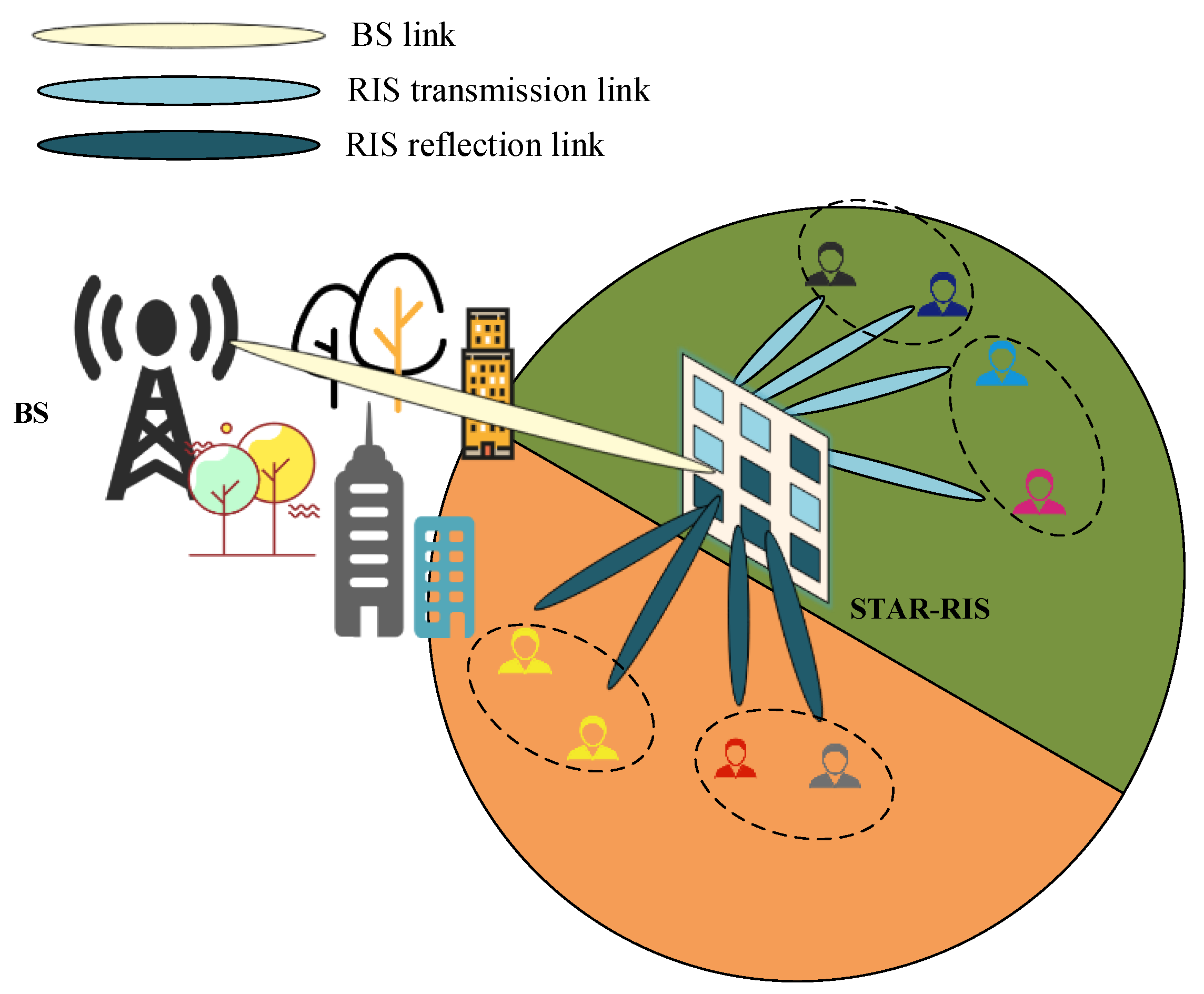
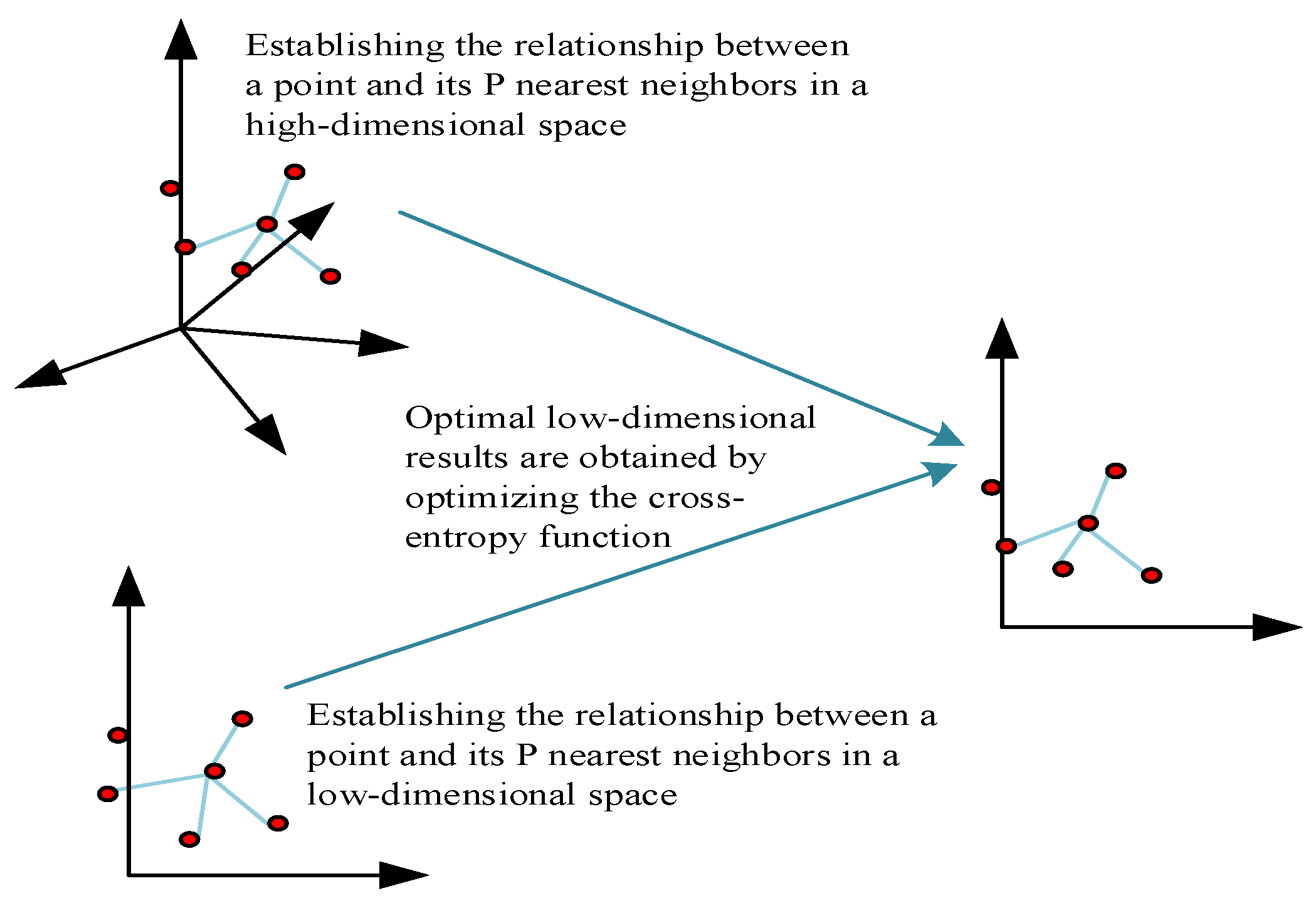
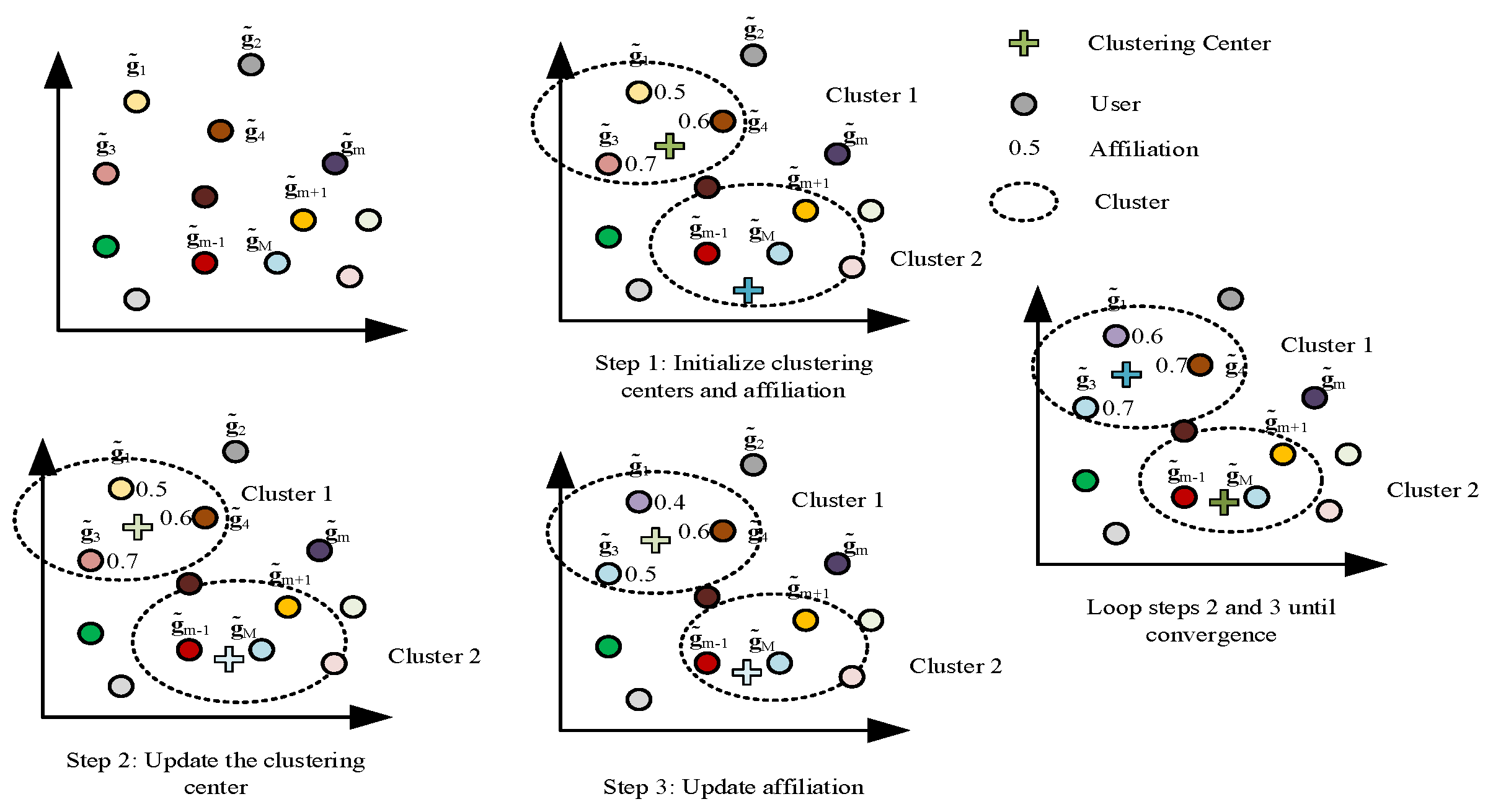
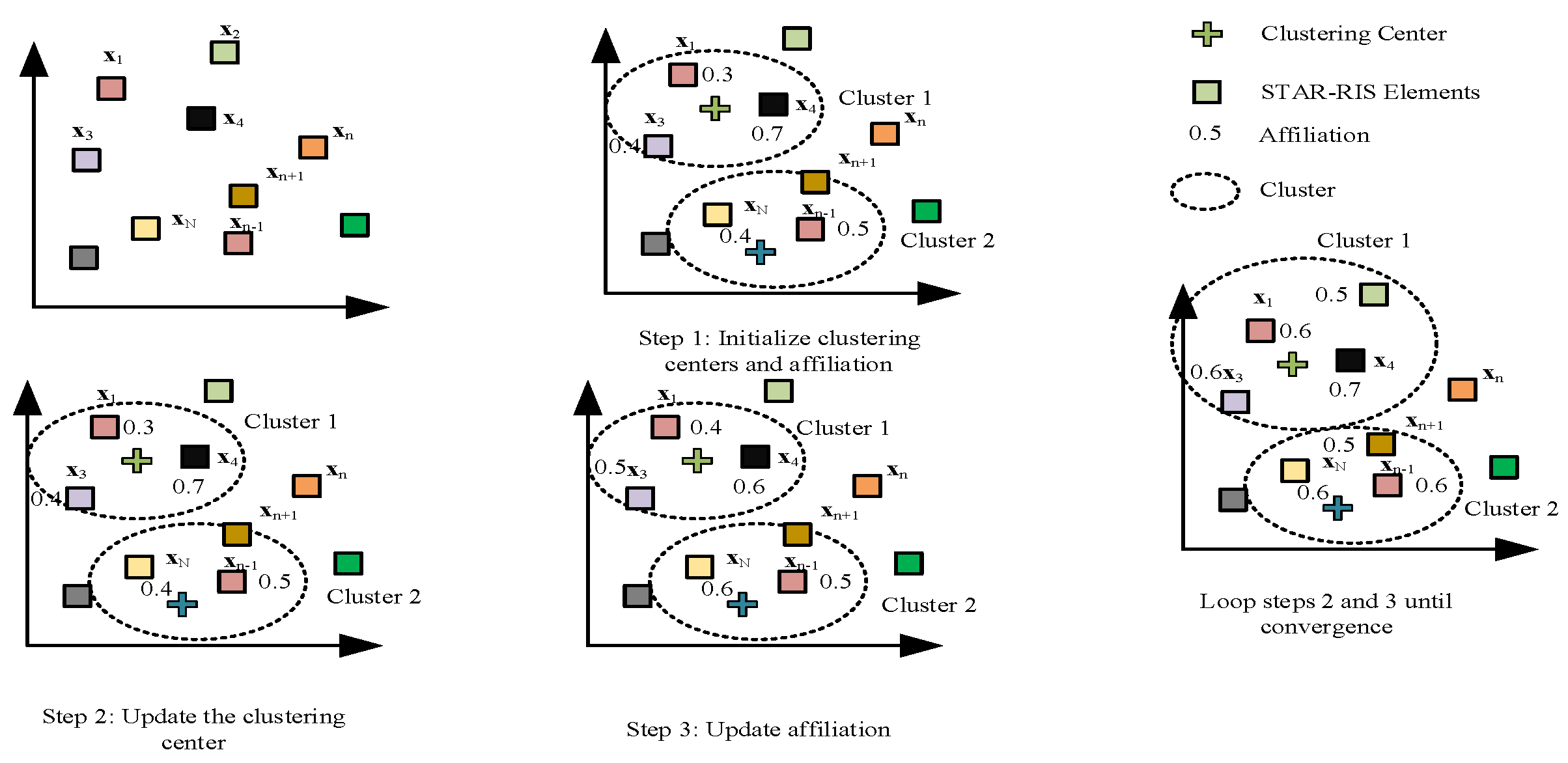


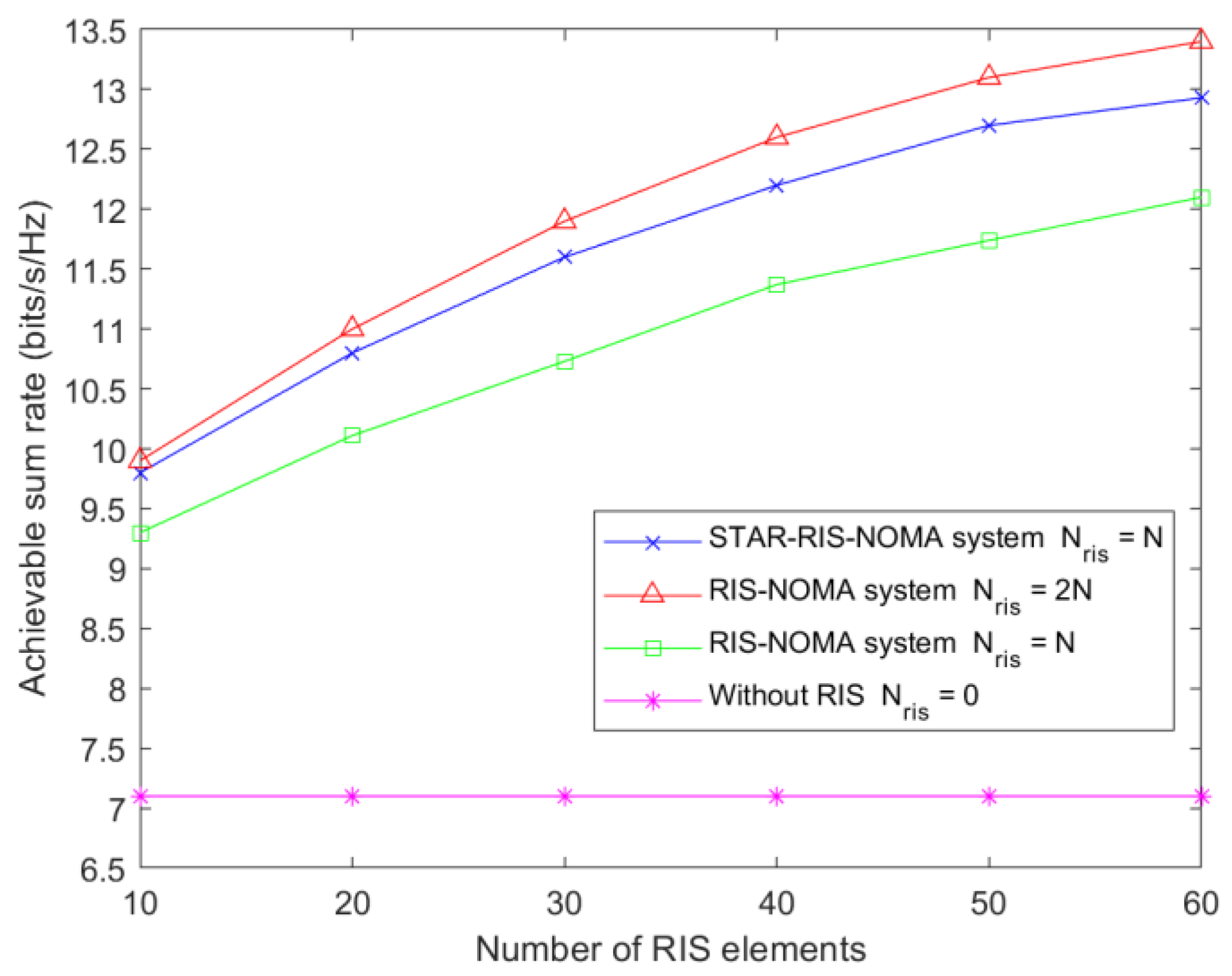
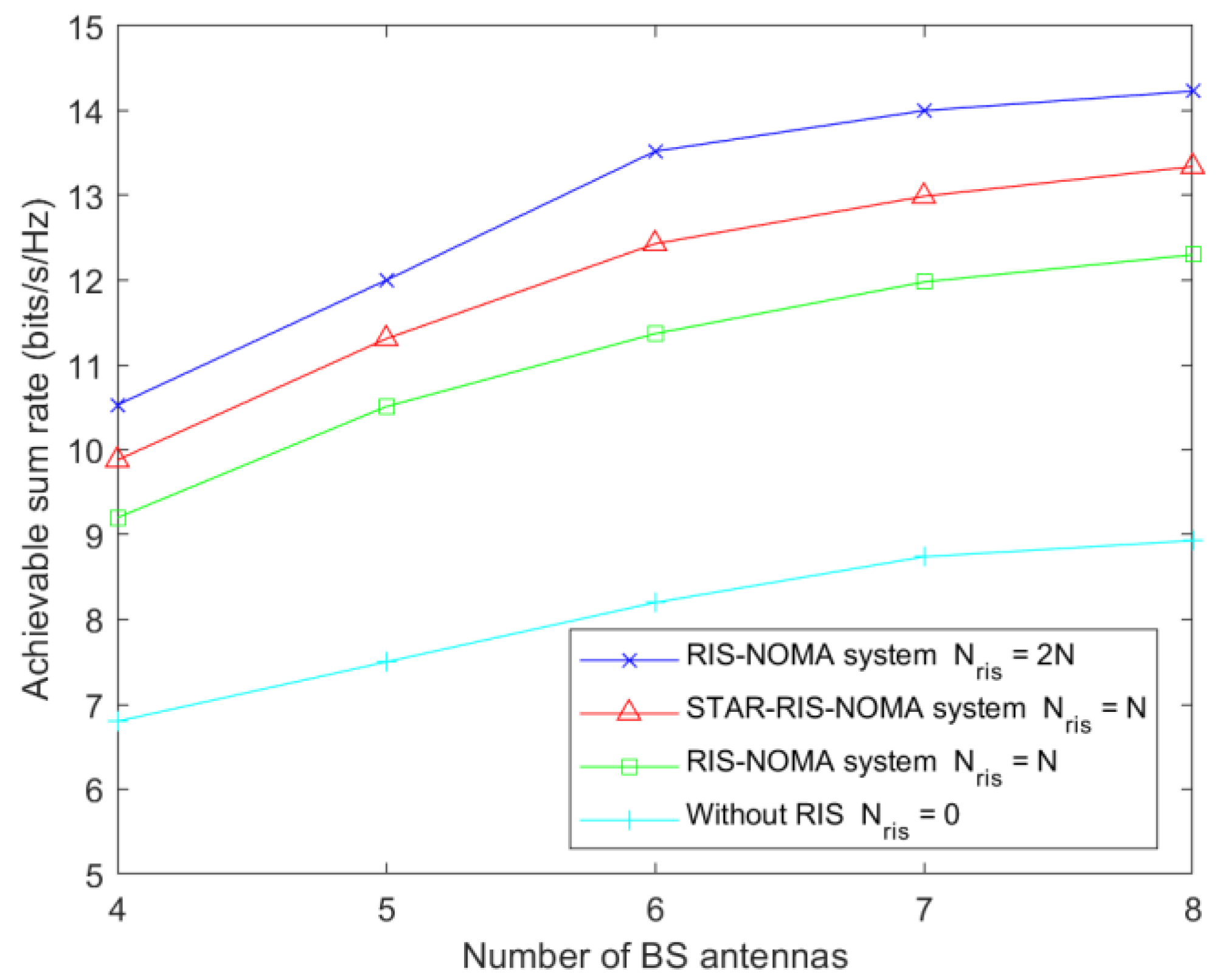
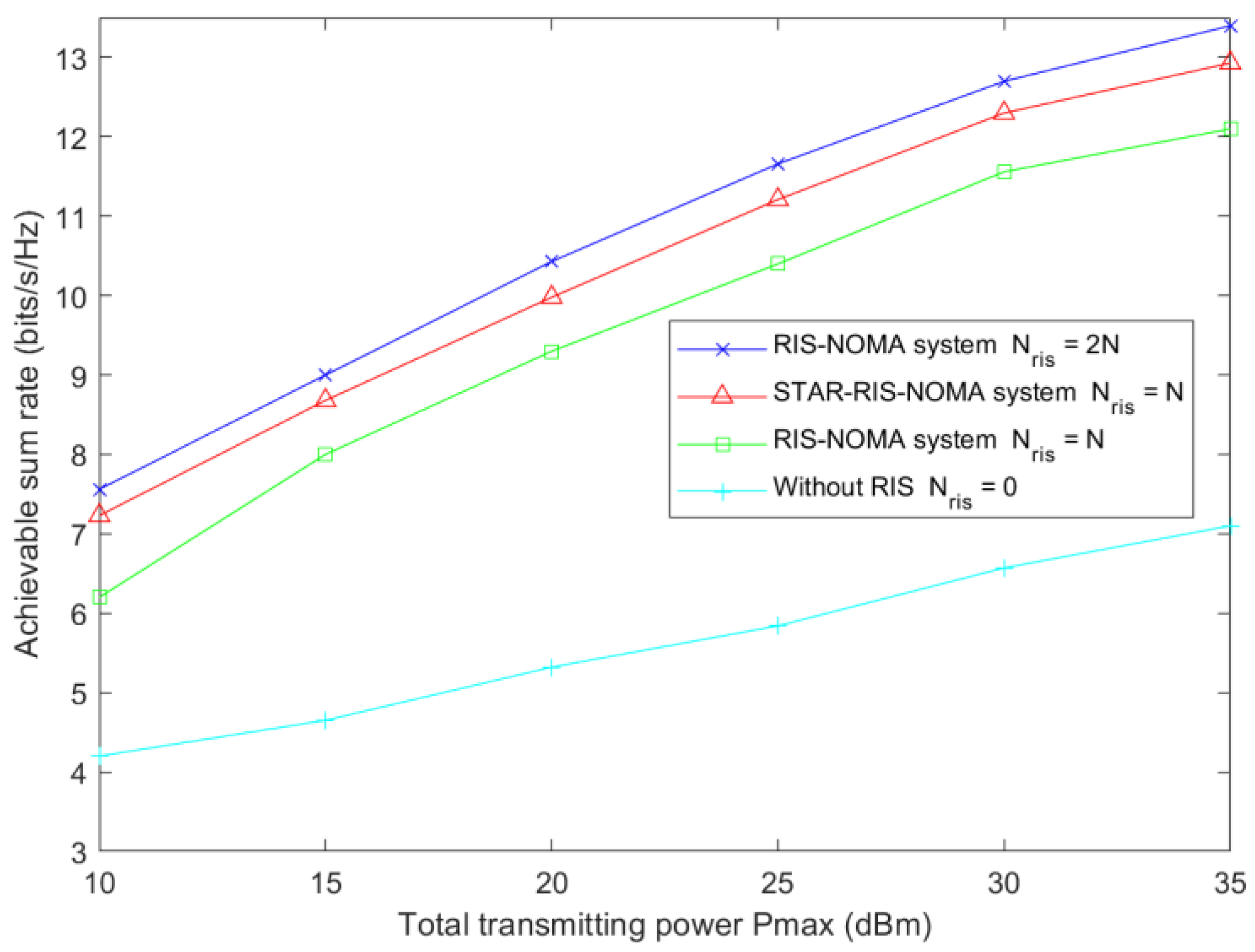
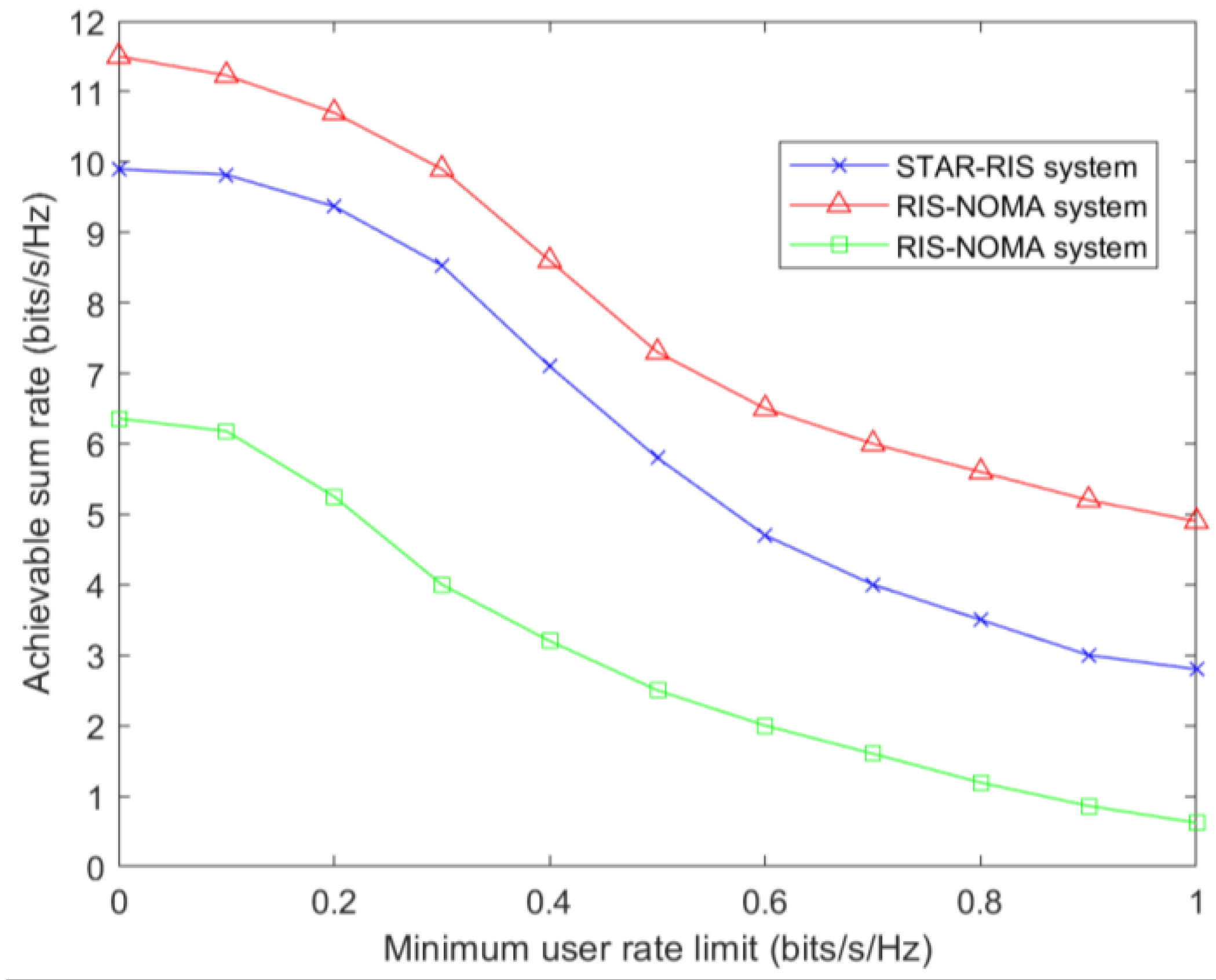
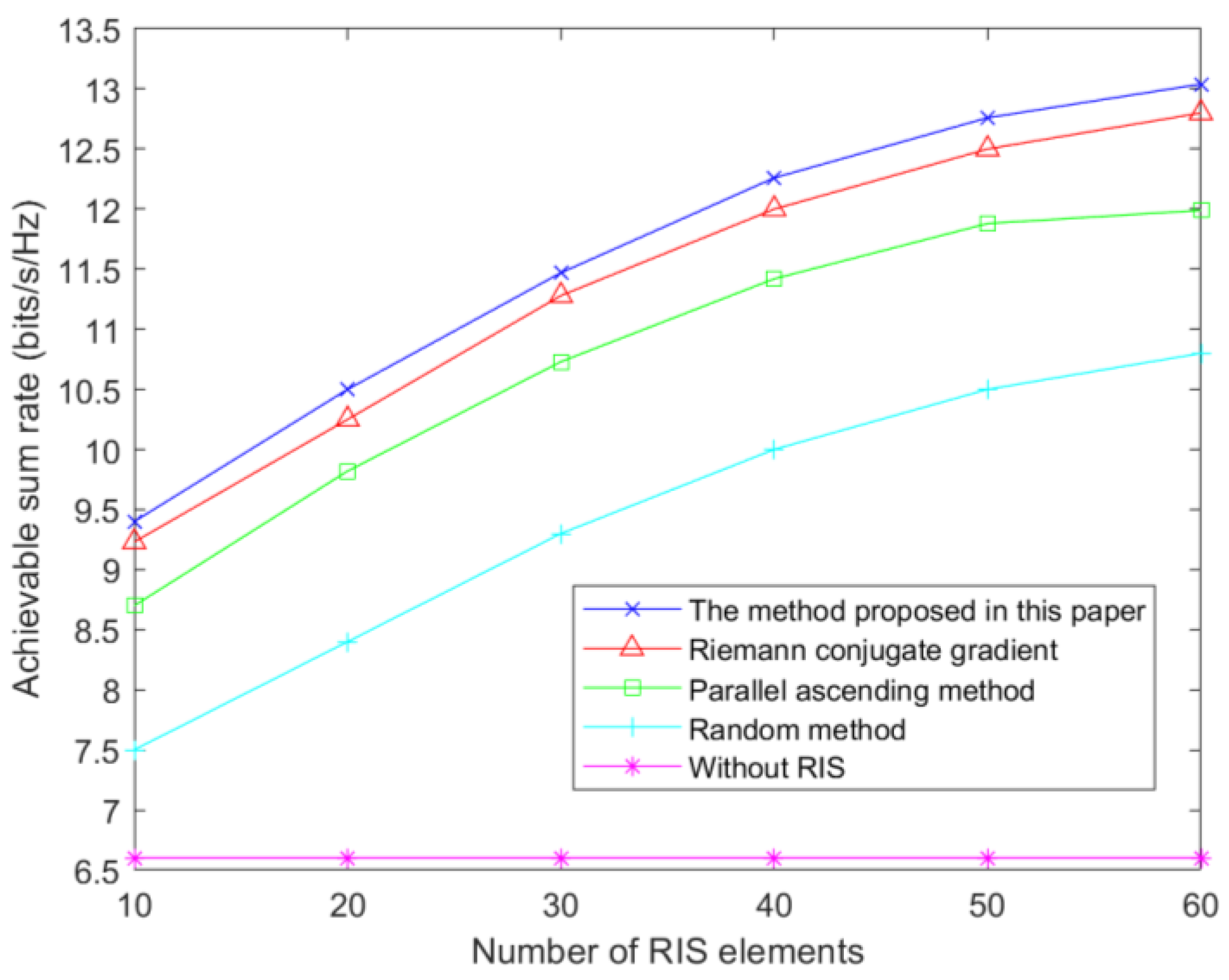

| Parameter | Parameter Explanation | Value |
|---|---|---|
| Rician factor for BS to STAR-RIS channels | 3 dB | |
| Rician factor of STAR-RIS to user channel | 3 dB | |
| Path loss at a reference distance of 1 m | −30 dB | |
| Path loss index for BS to STAR-RIS channels | 2.2 | |
| Path Loss Index for Path Loss Index | 2.2 | |
| Initialize penalty factor | 10−4 | |
| Maximum number of inner-layer iterations | 25 |
Disclaimer/Publisher’s Note: The statements, opinions and data contained in all publications are solely those of the individual author(s) and contributor(s) and not of MDPI and/or the editor(s). MDPI and/or the editor(s) disclaim responsibility for any injury to people or property resulting from any ideas, methods, instructions or products referred to in the content. |
© 2023 by the authors. Licensee MDPI, Basel, Switzerland. This article is an open access article distributed under the terms and conditions of the Creative Commons Attribution (CC BY) license (https://creativecommons.org/licenses/by/4.0/).
Share and Cite
Zhou, X.; Wang, H.; Chen, J. Joint Design of a Simultaneous Reflection and Transmission RIS in Mode-Switching Mode to Assist NOMA Systems. Sensors 2023, 23, 5504. https://doi.org/10.3390/s23125504
Zhou X, Wang H, Chen J. Joint Design of a Simultaneous Reflection and Transmission RIS in Mode-Switching Mode to Assist NOMA Systems. Sensors. 2023; 23(12):5504. https://doi.org/10.3390/s23125504
Chicago/Turabian StyleZhou, Xiaoping, Hanqi Wang, and Jiajia Chen. 2023. "Joint Design of a Simultaneous Reflection and Transmission RIS in Mode-Switching Mode to Assist NOMA Systems" Sensors 23, no. 12: 5504. https://doi.org/10.3390/s23125504
APA StyleZhou, X., Wang, H., & Chen, J. (2023). Joint Design of a Simultaneous Reflection and Transmission RIS in Mode-Switching Mode to Assist NOMA Systems. Sensors, 23(12), 5504. https://doi.org/10.3390/s23125504






